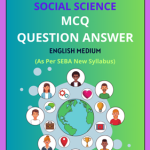SEBA Class 6 Social Science MCQ Chapter 3 Motions of the Earth Solutions in English Medium, Class 6 Social Science Multiple Choice Question Answer to each chapter is provided in the list so that you can easily browse throughout different chapters SEBA Class 6 Social Science MCQ Chapter 3 Motions of the Earth Question Answer and select need one.
SEBA Class 6 Social Science MCQ Chapter 3 Motions of the Earth
Also, you can read the SCERT book online in these sections SEBA Class 6 Social Science Objective Type Solutions by Expert Teachers as per SCERT (CBSE) Book guidelines. These solutions are part of SCERT All Subject Solutions. Here we have given Assam SEBA Class 6 Social Science MCQ Solutions for All Subject, You can practice these here.
Motions of the Earth
Chapter – 3
| MCQ |
1. What are the two main motions of the Earth?
(a) Rotation and Revolution.
(b) Rotation and Oscillation.
(c) Revolution and Oscillation.
(d) Oscillation and Vibration.
Answer: (a) Rotation and Revolution.
2. How long does it take for the Earth to complete one rotation on its axis?
(a) 12 hours.
(b) 24 hours.
(c) 365 days.
(d) 30 days.
Answer: (b) 24 hours.
3. What is the imaginary line called that the Earth rotates around?
(a) Equator.
(b) Tropic of Cancer.
(c) Axis.
(d) Prime Meridian.
Answer: (c) Axis.
4. The rotation of the Earth causes which phenomenon?
(a) Seasons.
(b) Day and Night.
(c) Phases of the Moon.
(d) Tides.
Answer: (b) Day and Night.
5. How long does it take for the Earth to complete one revolution around the Sun?
(a) 24 hours.
(b) 30 days.
(c) 365 days.
(d) 10 months.
Answer: (c) 365 days.
6. The Earth’s orbit around the Sun is:
(a) Circular.
(b) Elliptical.
(c) Rectangular.
(d) Triangular.
Answer: (b) Elliptical.
7. What causes the different seasons on Earth?
(a) The Earth’s rotation.
(b) The Earth’s tilt and revolution.
(c) The distance from the Sun.
(d) The Earth’s magnetic field.
Answer: (b) The Earth’s tilt and revolution.
8. During which month does the Summer Solstice occur in the Northern Hemisphere?
(a) March.
(b) June.
(c) September.
(d) December.
Answer: (b) June.
9. What is the longest day of the year in the Northern Hemisphere called?
(a) Winter Solstice.
(b) Summer Solstice.
(c) Equinox.
(d) Mid-summer.
Answer: (b) Summer Solstice.
10. Which two days of the year have equal day and night duration?
(a) Solstices.
(b) Equinoxes.
(c) Midsummer and Midwinter.
(d) Eclipse days.
Answer: (b) Equinoxes.
11. The shortest day of the year in the Northern Hemisphere is called:
(a) Winter Solstice.
(b) Summer Solstice.
(c) Equinox.
(d) Mid-winter.
Answer: (a) Winter Solstice.
12. What is the angle of the Earth’s axial tilt?
(a) 15.5 degrees.
(b) 23.5 degrees.
(c) 30.5 degrees.
(d) 45.5 degrees.
Answer: (b) 23.5 degrees.
13. Which phenomenon is responsible for the varying lengths of day and night throughout the year?
(a) Earth’s rotation.
(b) Earth’s revolution.
(c) Earth’s tilt.
(d) Moon’s phases.
Answer: (c) Earth’s tilt.
14. The line that divides the Earth into the Northern and Southern Hemispheres is called the:
(a) Prime Meridian.
(b) Equator.
(c) Tropic of Cancer.
(d) Tropic of Capricorn.
Answer: (b) Equator.
15. What is the phenomenon called when the Sun is directly above the Equator?
(a) Solstice.
(b) Equinox.
(c) Eclipse.
(d) Zenith.
Answer: (b) Equinox.

Hi! my Name is Parimal Roy. I have completed my Bachelor’s degree in Philosophy (B.A.) from Silapathar General College. Currently, I am working as an HR Manager at Dev Library. It is a website that provides study materials for students from Class 3 to 12, including SCERT and NCERT notes. It also offers resources for BA, B.Com, B.Sc, and Computer Science, along with postgraduate notes. Besides study materials, the website has novels, eBooks, health and finance articles, biographies, quotes, and more.




